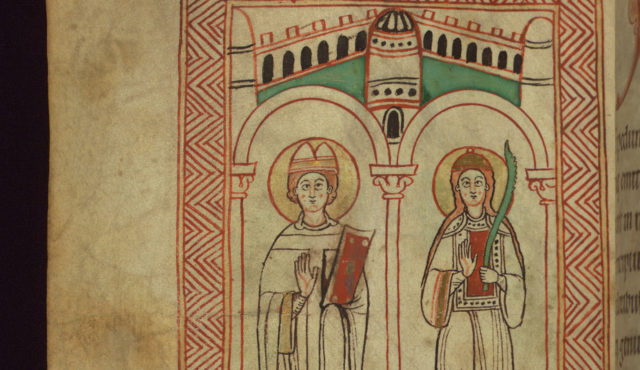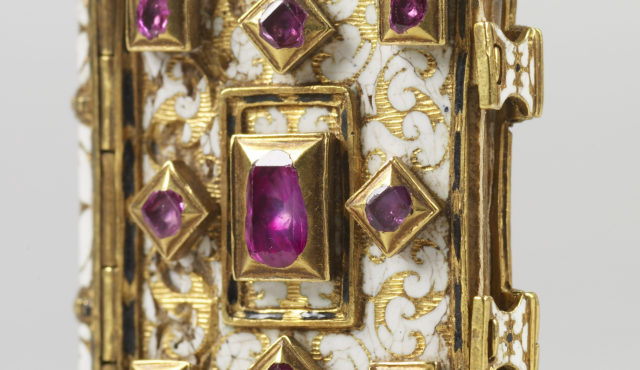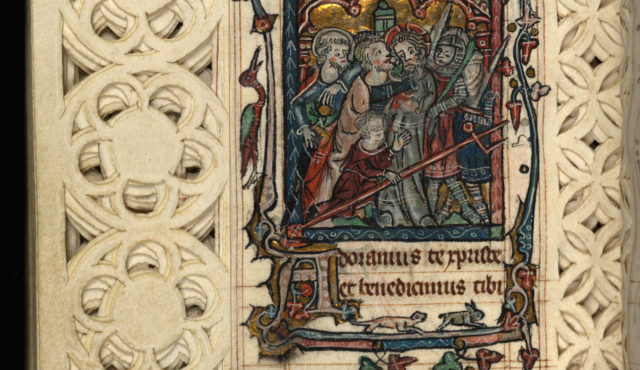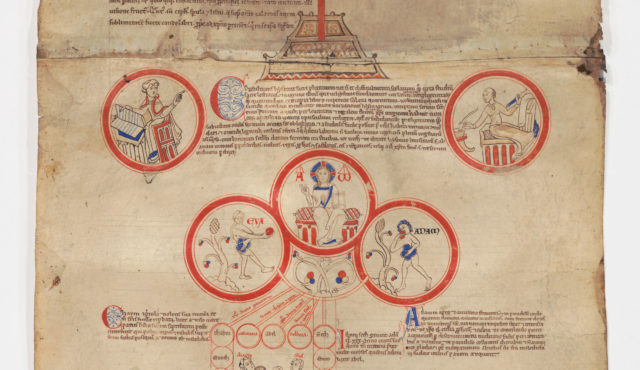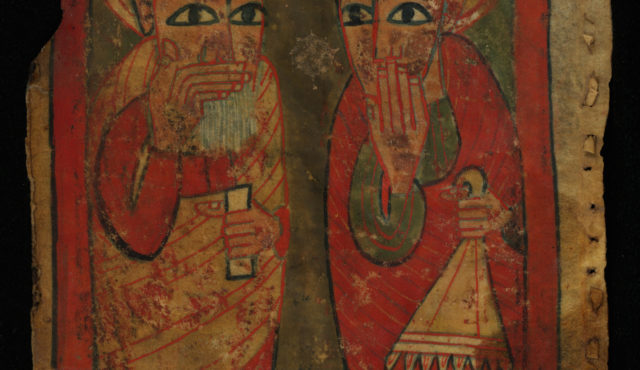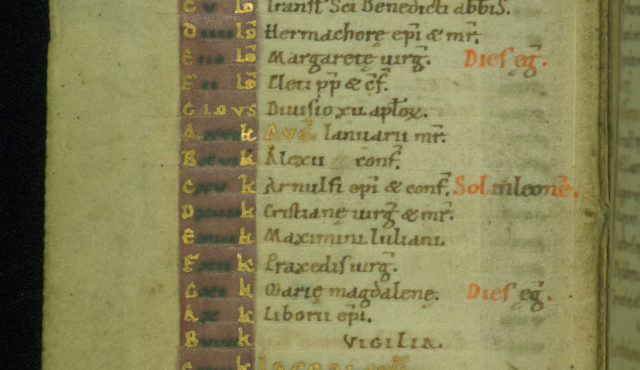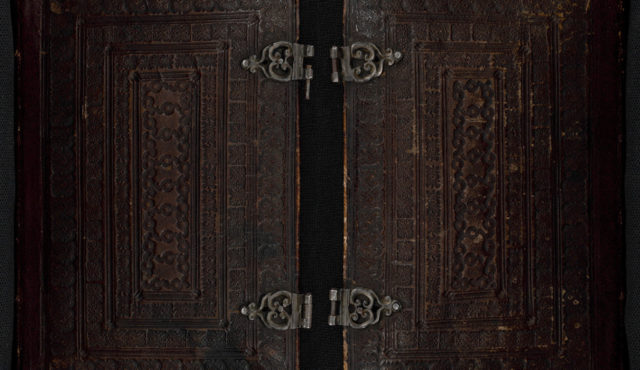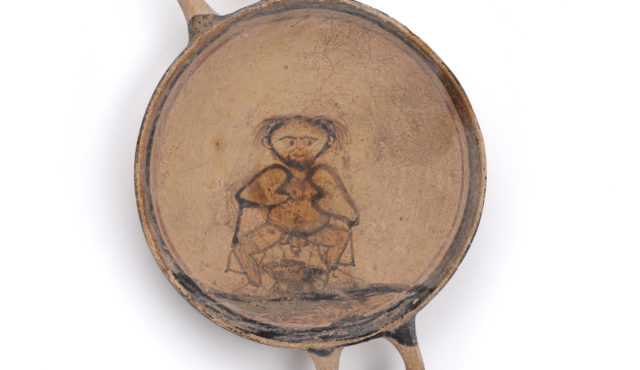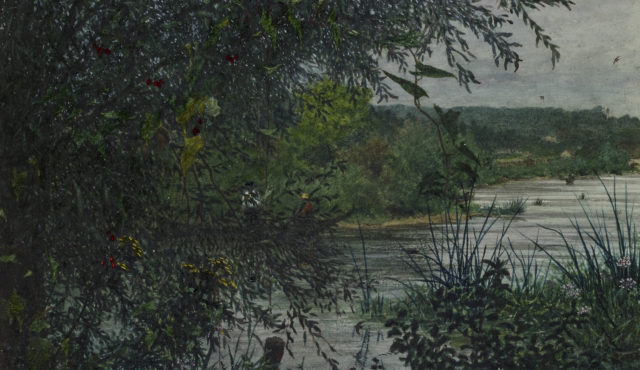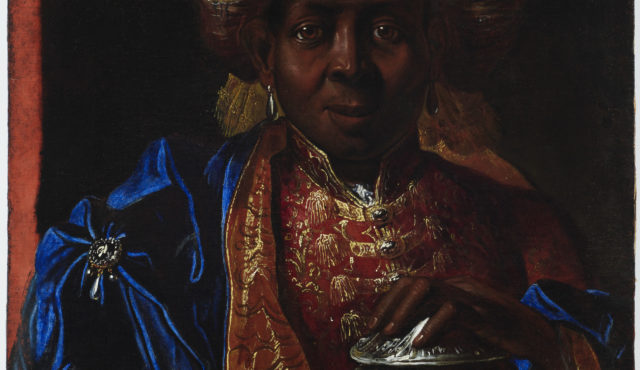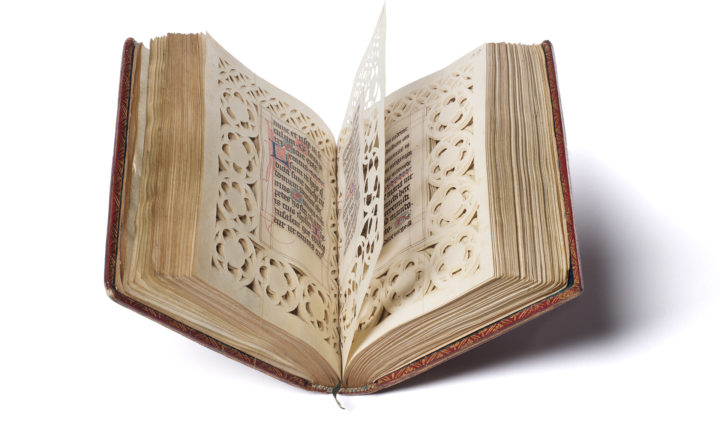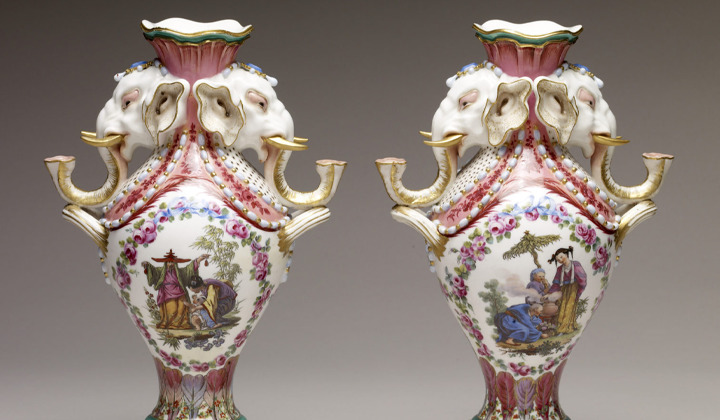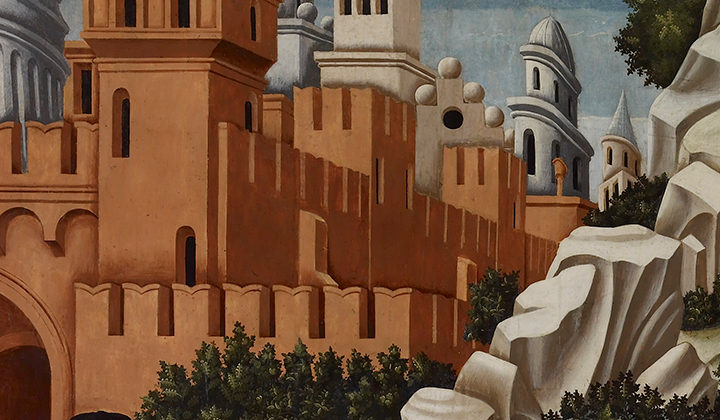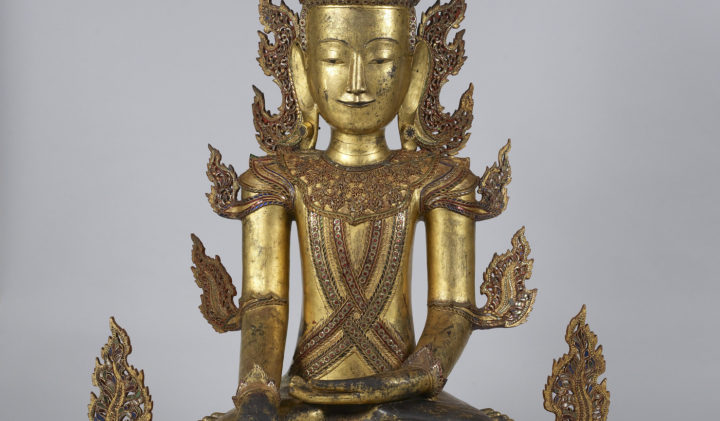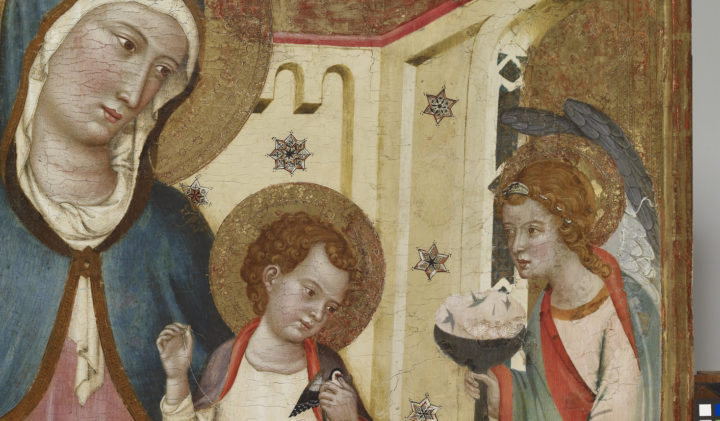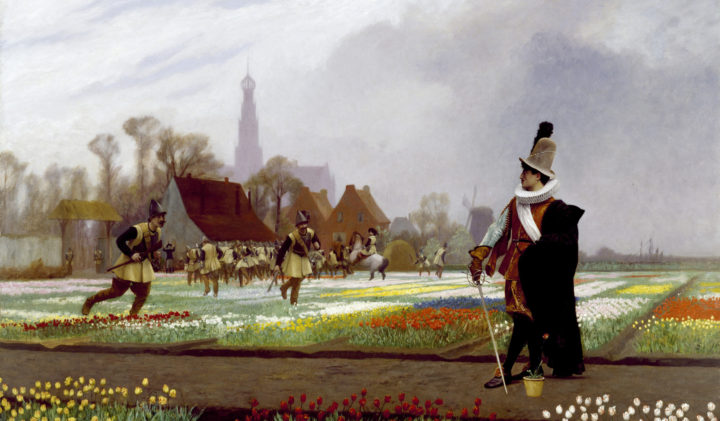The Helmarshausen Psalter (Walters Art Museum, acc. no. W.10) has long been characterized as the “little sister” of another, far more famous twelfth-century manuscript: The Gospels of Henry the Lion (Herzog August Bibliothek, Wolfenbüttel, acc. no. Cod. Guelf. 105 Noviss. 2° and Bayerische Staatsbibliothek, Munich, acc. no. Clm 30055).[1] The latter shot to celebrity status when it was auctioned at Sotheby’s for £8,140,000 in 1983, becoming the world’s most expensive book—a title it maintained until 1994, when Bill Gates purchased Leonardo da Vinci’s Codex Leicester.[2] While Gates’s interest in Leonardo reflected an appreciation for the history of science, and perhaps a desire to connect his own reputation as a “genius” to that of a universally acclaimed Renaissance man, the appeal of the Gospel book was rooted in a very different set of factors. Its 1983 acquisition by a consortium of state-owned libraries in pre-unification Germany signaled a gradual rehabilitation of national identity after a traumatic modern history of fascism and division.[3] Much of the manuscript’s appeal lay in a romantic appreciation of its patron Henry the Lion (1129–1195), the ambitious and unlucky duke of Saxony and Bavaria whose rocky political fortunes were closely intertwined with his investment in lavish artworks destined for his capital city of Braunschweig. This point, however, is inextricably linked to the extraordinary qualities of the manuscript itself, which was almost certainly among Henry’s costliest gifts to Braunschweig and boasts a pictorial program of virtually unmatched richness among surviving European codices of the twelfth century, or the late Romanesque period more generally.
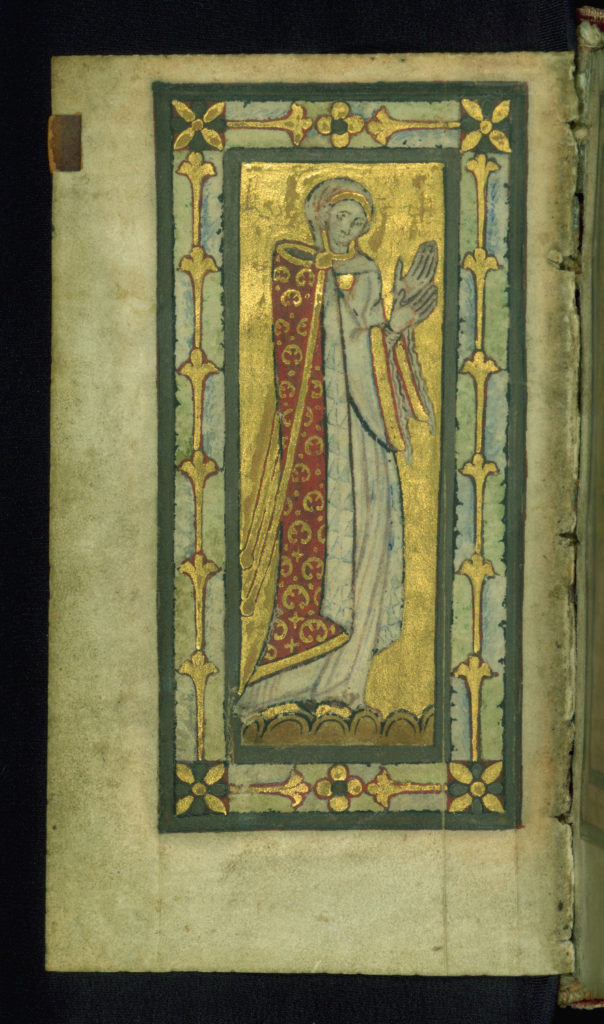
Unknown German artist, Aristocratic lady at prayer, Helmarshausen Psalter, Germany (Helmarshausen), second half of the twelfth century, ink and pigment on parchment. The Walters Art Museum, Baltimore, acquired by Henry Walters, 1903, acc. no. W.10, fol. 6v
All of this offers a dramatic contrast for the Helmarshausen Psalter (or “W.10”), which has a relatively modest image cycle and was purchased without fanfare from the Paris bookbinding firm of Gruel & Engelmann by Henry Walters in the years around 1900. The medieval art historian Adolph Goldschmidt examined the manuscript shortly before the collection was opened to the public as the Walters Art Gallery in 1909; the manuscript was later part of the original 1931 Walters bequest to Baltimore, and Goldschmidt’s assessment was published in the inaugural 1938 issue of the present journal.[4] Already at this early date Goldschmidt was able to identify the book not only as a product of the scriptorium of Helmarshausen, an abbey in Saxony that produced outstanding manuscripts and metalwork throughout the twelfth century, but also the work of the scribe Herimann, named in the dedication poem of the Gospels of Henry the Lion and probably a Helmarshausen monk.[5] This attribution has since been sustained, together with Goldschmidt’s central supposition that the psalter was likely made for a woman of Henry the Lion’s family, perhaps a wife or daughter.[6] This appealing association between the psalter and Henry’s dynasty rests on the assertion that the powerful duke who commissioned the now-famous Gospel book and also the Psalter of Henry the Lion (British Library, London, acc. no. Lansdowne 381) would also be the patron of a smaller, more modest psalter for the private use of a close family member. Its key piece of evidence is an enigmatic full-page depiction of an aristocratic woman at prayer on fol. 6v, widely viewed as a portrait of the book’s original owner (fig. 1).
Most discussions of the Helmarshausen Psalter, taking this assessment as a point of departure, have since focused on the question of which wife or daughter was the most likely recipient of such a gift and thus the subject of the portrait page. Alongside Mathilda, Henry’s second wife from 1168 until her death in 1189, another popular suggestion has been Henry’s daughter Gertrude from his first marriage to Clementia of Zähringen, or even Clementia herself, whose 1147 marriage to Henry ended in divorce in 1162. Gertrude was born in 1152 or 1155; she married Frederick IV, duke of Swabia, in 1166 but was widowed the following year. Her second marriage in 1177 to Knut VI later made her a Danish queen. Goldschmidt hypothesized that the psalter could have been sent to Denmark with Gertrude, along with two Helmarshausen Gospel books formerly in the Cathedral of Lund, now in Uppsala (University Library, acc. no. C 83) and Copenhagen (Royal Library, acc. no. Thott 21 4to)—an appealing idea, though there is nothing in the manuscript’s provenance to suggest it was ever in Scandinavia.[7] While few subsequent studies have adopted Goldschmidt’s analysis completely, many have persisted with this biographical method and attempted to correlate the manuscript to major events in the lives of Henry’s wives and daughters. Those favoring a date closer to 1150 have identified the woman as Clementia; those making a case for ca. 1166 or ca. 1177 have suggested Gertrude; and those who wish to see the woman as Mathilda emphasize that this psalter could be roughly contemporary to the Gospels and Psalter of Henry the Lion.[8] These manuscripts are likewise controversial in date; the Psalter could have been produced at any point during Mathilda’s marriage to Henry the Lion (which lasted from 1168 until her death in 1189) and the date range for the Gospels is only slightly narrower (1173–1189) because it includes an image of Thomas Becket as a saint.[9] Pinpointing a date for any of these manuscripts on stylistic evidence alone is a difficult task, given that there is more continuity than difference in the Helmarshausen workshop in the period from roughly the 1150s to 1180s. This makes arguments aimed at linking the date of the Walters Helmarshausen Psalter to the biography of any specific woman somewhat circular almost by nature.
Reconstructing the manuscript’s history largely on the basis of biographies and portraits is further complicated by the fact that there were many more women in Henry’s circle that have never been included in the conversation. To name but one, recent work by Clara Harder has shown that Henry treated his natural daughter, also named Mathilda, as the equal of his legitimate children.[10] This should not be astonishing; many aristocratic medieval children born outside of marriage, from Drogo of Metz in the ninth century to Anthony of Burgundy in the fifteenth, were recognized by their fathers and rose to prominence.[11] But the regularity with which this daughter is overlooked as one of the possibilities for the book’s owner offers a reminder of how misleading and reductive the most common hypotheses have been: only the very obvious names are put forward, even though we know there are major gaps in the archive. My point here is hardly to advocate for introducing yet more names to the list of possibilities but rather to suggest that, given the complexity of Henry’s family tree, the difficulty of dating the psalter precisely, and, above all, the simple fact that the woman herself is not named within the manuscript, looking to pinpoint the woman’s identity is probably not the most productive approach to understanding either the codex or the broader culture that surrounded it.
The goal of this essay, therefore, is to shift attention from the question of who the portrait page represents, to how its presence shapes the psalter as a whole, emphasizing major points of uncertainty and suggesting that the identification of the manuscript with “a lady” from Henry’s family might itself be more useful than fixating on which lady. Rather than seeking correlations to the biography of a specific woman, I instead reassess the Helmarshausen Psalter as a whole, and in relation to other codices, including the Gospels and Psalter of Henry the Lion. I contend that the notion of “portraiture” in the twelfth century requires much the same qualification that has lately been applied to the concept of the “individual”: in both cases, a certain modern readiness to look for singular biographies and personal experiences in the Middle Ages can lead us to ignore the tensions of anonymity.[12] It is, however, precisely the relationship between the individual and their social type that lent meaning to twelfth-century portrayals of elite identity. It is to this latter category, perhaps less appealing to our tastes than “the individual” and yet possessing its own distinctive meanings, that I believe the aristocratic lady should be assigned. In order to make this point, however, the portrait page needs to be approached first and foremost in its codicological context, and not through a fixation on the Guelph family tree.
The Helmarshausen Psalter is a tiny codex, just 6.5 centimeters in width and 11.5 centimeters in height with a written surface of 4 x 9.2 centimeters. Though no longer in its original binding, the generous margins on the bottom and outer sides of each leaf suggest the codex is close to its original size; only the top edge with its much smaller margins indicates substantial losses of perhaps two centimeters or more when it was trimmed during rebinding. Of its 127 folios, all but two are original; two plain ruled pages that were added later to the beginning and end of the codex (fols. 1 and 127) are included in the modern foliation. The Latin text includes a calendar (fols. 2r–6r) and liturgical psalter (fols. 6v–111v); canticles, hymns, and creeds (fols. 111v–121v); litany, petitions, and collects (fols. 121v–124r); and a minor office of the dead (fols. 124r–126v). The latter ends imperfectly in the midst of an antiphon for lauds (venit ad me non eiciam), meaning some folios were long since detached and lost from the back of the codex. Given that there are no images in this section, however, it seems all but certain that these lost pages also lacked pictures.

Calendar page for April, Helmarshausen Psalter, acc. no. W.10, fol. 2r

Helmarshausen Psalter (W. 10), fols. 3v-4r showing thread at the center of the quire.
Three folios appear to be missing from the first quire of the codex as well. The calendar is arranged regularly with each month contained on one full side of a page; it begins with April on the first surviving original page (fig. 2), suggesting at least two leaves have been lost: one with January on its verso (the first “lost” page, or L1), and another with February on the recto and March on the verso (L2). The final month, December (fol. 6r), lands on a leaf that has lost the other half of its bifolium. Given that folio 6 is also the last leaf of the quire, this means that the other half of folio 6 was possibly once the missing leaf with the calendar pages for February and March (L2). Even a cursory inspection of the codex confirms that folios 3 and 4 are part of the same bifolium; the thread holding the quire in place is readily visible at the juncture of 3v‒4r (fig. 3). The foliation of the entire codex has yet to be fully determined due to its relative fragility; still it seems plausible that it was once arranged in regular quarternions, as was common across twelfth-century Europe. The first quire may thus be tentatively reconstructed as follows:

Whether the recto of L1 was once decorated with image or text, or if additional pages were once inserted at the start of the book, remains unknowable: yet it would not be surprising for the recto of the initial folio to be left blank, and it is fairly standard for psalters to begin with the calendar. Nor does it seem likely that the missing January, February, and March pages (fols. 1v–2v) were significantly different from the calendar pages that survive; surely, they also featured porphyry-like purple columns at left containing golden numbers and dominical letters, and the names of saints arranged vertically with certain dates highlighted in red or gold.[13]
The only truly vexing riddle, therefore, is the missing contents of L3. The stakes of the question are raised by the fact that folio 6v, following the conclusion of the calendar on folio 6r, contains the elegantly drawn “portrait” miniature. The woman appears dressed in aristocratic clothes that echo the garments worn by women in the Gospels of Henry the Lion; chief among these is Henry’s wife, the English princess Mathilda, daughter of Henry II and Eleanor of Aquitaine, whose lavish robes in the oft-published dedication and coronation miniatures are similar in shape, colors, and textile patterns (figs. 4 and 5). As Elisabeth Klemm has noted, however, the stylistic similarities between these figures and Mathilda in the other manuscripts are limited. Comparing the cloaks, for example, Mathilda’s hoods fall back in gentle curves; the Walters woman’s cloak has a sharp, angular fold so that the hood forms a crisp, shallow scallop.[14] Despite these differences, however, I am struck by the conversely identical scales of these figures. Although the psalter is much smaller than the Gospels of Henry the Lion, portraits in both manuscripts measure roughly 2.75 inches. Thus, we might suggest a different artist at work for the Walters Helmarshausen Psalter, but one that is using the same set of models, looking at the same style of cloak, and perhaps working for the same circle of patrons. Further, if seen together, the shared sizes of the portrait figures would help viewers understand the codices as members of the same group, unified through the shared scale of their figural decoration, a point of resonance only made more striking by the overall disparity in the books’ sizes.

Unknown German artist, Portrait figures on the dedication page, Gospels of Henry the Lion, Germany (Helmarshausen), second half of the twelfth century, ink and pigment on parchment. Herzog August Bibliothek, Wolfenbüttel, 1983, acc. no. Noviss. 2° and Bayerische Staatsbibliothek, Munich, acc. no. Clm 30055, fol. 19r

Portrait figures on the coronation page, Gospels of Henry the Lion, Herzog August Bibliothek, Wolfenbüttel, acc. no. Noviss. 2° and Bayerische Staatsbibliothek, Munich, acc. no. Clm 30055, fol. 171v

Beginning of Psalm 1, Helmarshausen Psalter, acc. no. W.10, fols. 6v–7r
Hands raised in prayer, the woman in the Helmarshausen Psalter looks across the opening at the decorated B of the words Beatus vir that open Psalm 1 (fig. 6). If the reconstructed quire structure is correct, the portrait once formed the left half of a diptych-like opening and her gaze led to L3r, an image which has long since been lost. The absence of L3 has been noted from Goldschmidt’s time onward and has often been treated—whether implicitly or explicitly—as something of a roadblock for achieving a true understanding of the manuscript. Perhaps the opening once showed the lady praying to her name saint, or else contained some other signifier that would allow her identity to be pinpointed. What I wish to suggest here, however, is that this is actually quite unlikely; it is far more plausible that the contents of L3, much like those of the other missing folios, were somewhat formulaic and that—when all is said and done—there is no good reason to blame the anonymity of the woman on the absence of L3, or to allow its loss to stymie analysis of the manuscript. If we look at the psalter’s image cycle as a whole, beyond the sole figure of the praying woman, we can not only shift our understanding of the portrait but also offer interpretations of the psalter that do not necessarily hinge on a narrow understanding of the owner’s identity.

Helmarshausen Psalter (W. 10), fols. 41v-42r showing the beginning of Psalm 51.

Helmarshausen Psalter (W. 10), fols. 77v-78r showing the beginning of Psalm 101.

Beginning of Psalm 109, Helmarshausen Psalter, acc. no. W.10, fols. 88v–89r
The Walters manuscript contains two more full-page miniatures, appearing on similarly structured verso pages that face large, decorated initials. The first of these is an opening with a Crucifixion on the left and the Q of Quid gloriaris on the right, the start of Psalm 51 (fig. 7). Christ hangs gently from a red cross flanked by Mary and John, surrounded by elegant geometric forms that include a flower-like sun and crescent moon in the upper quadrants of the page. A similarly balanced aesthetic marks the last of the full-page miniatures, which shows Christ in Majesty on the left and the D of Domine exaudi on the right to mark the beginning of Psalm 101 (fig. 8). The sum is three decorated openings that divide the psalms into equal thirds, with fifty psalms in each subsection—a not uncommon arrangement for an illuminated psalter. The only other decorated initial appears at the beginning of Psalm 109, Dixit dominus (fig. 9); this particular psalm was often embellished in luxury psalters. This initial lands on a verso, rather than a recto as is the case in the three initials facing full-page images. Seeing the full-page miniatures as a sequence also gives useful context to the portrait opening. While moving through the book from left to right, the reader observes the owner entering the Psalm text; if instead the book is held in the left hand, and the reader uses their right hand to navigate through the pages to a specific Psalm, the three verso pages appear in a neat stack with Christ in Majesty at the top, the Crucifix in the middle, and the owner on the bottom. We can even imagine readers thumbing through the pages this way, using the illuminations to help find the way to a specific Psalm and habitually seeing the praying woman “beneath” the devotional scenes that rest above her.

Unknown French artist, King David as Psalmist, Saint Rupert Psalter, France, late ninth century, ink and pigment on parchment. Archives of St. Peter’s Abbey, Salzburg, acc. no. Cod. A I. 0, fol. 2r; facsimile edition (Graz: Akademische Druck- u. Verlagsanstalt, 2007). Photo credit: Sarah Daiker
Given that the surviving pages show the owner, a Crucifixion, and a Christ in Majesty, there is little room to imagine that L3r could show anything other than perhaps a Madonna and Child, serving as a focal point of prayer for the aristocratic woman. This is, indeed, suggested in the literature.[15] Conversely, an equally obvious choice for the recto would be David with his harp, facing the Beatus vir, the opening text of Psalm 1. Depictions of David appear in psalters from the earliest illuminated examples onward; to name but one, the tiny ninth-century Saint Rupert Psalter (Archives of St. Peter’s Abbey, Salzburg, acc. no. Cod. A I. 0) offers a Carolingian model that is similar in scale and richness to the Helmarshausen Psalter, albeit with David on a recto rather than a verso (fig. 10).[16] While it is easy enough to imagine images of Mary and David inserted on L3, it seems likely that the depictions would be somewhat conventional, in keeping with the rather staid nature of the surviving illuminations.

Unknown German artist, Jerome and Pope Damasus, Gospel book, Germany (Helmarshausen), ca. 1140, ink and pigment on parchment. University Library, Uppsala, acc. no. C 83, fol. 1v
Upon further reflection, what can be ruled out is Goldschmidt’s initial suggestion that the choice of saint may once have identified the woman. Perhaps he was thinking of later medieval artworks in which donors with names like Catherine or George were often depicted in the company of their name saints: yet even in such works, donors rarely pray to their patronymic saints; rather, these saints usually present them to a holy figure—often Mary, as in the case of Jan van Eyck’s Virgin and Child with Canon van der Paele (Groningen Museum, Bruges, acc. no. 0.161.1). In the twelfth century, however, these pairings were uncommon—as were depictions of saints with the sorts of names that are found among aristocratic women in the orbit of Helmarshausen, such as Mathilda, Gertrude, or Clementia. In the case of the Gospels of Henry the Lion, Henry and Mathilda turn not to their personal patrons, but rather to the institutional patrons of the city and collegiate church; in the context of a grand codex likely displayed to a limited public, the goal was as much to show the aristocrats as co-patrons with the saints as it was to cement their own memoria and eventual salvation. Looking more broadly at portraits in Helmarshausen codices, we might also note the frontispiece of the Gospel book in Uppsala (fig. 11), which shows Jerome presenting his translation to Pope Damasus. Much like the lords and ladies in the Gospels of Henry the Lion, Jerome and Damasus have their names neatly inscribed in framing devices above their heads. Perusing these manuscripts, one point seems increasingly clear: no matter what may have been on L3, there is little likelihood that it offered clues for the identity of the woman in the Helmarshausen Psalter. Intended for personal rather than institutional use, the little codex hardly required an emblazoned name for the portrait page to function. Though simple, this observation has important consequences for our understanding of the Romanesque portrait.
There is, however, one more possibility concerning folio L3, one that strikes me as ultimately even more convincing than a lost page with images of an enthroned Madonna and David as psalmist. It is quite conceivable that L3 never existed, and the opening “quarternion” was always intended as a quire of seven rather than eight leaves. If L1 was once a singleton (meaning a single leaf that does not appear as one half of a bifolium), and L2 connected to folio 6, this would mean the gathering was planned to show the woman simply facing Psalm 1 and thus enacting a prayerful entrance into the sacred text. This would in turn create a pleasing regularity for the book overall, with Psalms 1, 51, and 101 all comprised of lavish openings with a full-page image on the left and a decorated Psalm opening on the right.

Unknown French artist, Aristocratic lady at prayer, Fécamp Psalter, France (Fécamp), ca. 1180–1200, ink and pigment on parchment. Koninklijke Bibliotheek, The Hague, acc. no. 76 F 13, fols 28v–29r
An arrangement with the donor facing the Psalm text is far from common, but we do find the same composition in the contemporaneous Fécamp Psalter now in the Hague (Koninklijke Bibliotheek, acc. no. 76 F 13), produced ca. 1180–1200. In its best-known opening, an aristocratic woman raises her hands in a gesture of prayer as she gazes across the diptych-like arrangement to the historiated B of Beatus vir on the right (fig. 12).[17] Like the Helmarshausen Psalter, the owner of the Fécamp Psalter is left anonymous; there is no inscription, and the studded belt, rich cloak, and delicate veil are too generic to allow for a precise identification. Though the clothing and architectural framing of the Fécamp Psalter bears little resemblance to the Helmarshausen woman or the thick, enamel-like border that surrounds her, it shows affinities to “Channel Style,” a lavish decorative type marked by coiling foliage that was popular in elite centers of production along both sides of the English Channel in England and France in the later twelfth century. It has been argued that the Helmarshausen scriptorium likewise drew upon Channel Style models in crafting initials like the B of its Beatus vir (fig. 6) with its lush spirals and abstracted foliage accents.[18] In other words, though the Fécamp and Helmarshausen Psalters first appear strikingly different in style, they emerge from a broadly related artistic context; the marriage of Henry the Lion to Mathilda, daughter of Henry II and Eleanor of Aquitaine, provides a clear point of contact between Saxony and the English Channel. It is not hard to imagine the owners of both manuscripts moving in similar circles. It is thus striking that, although the arrangement of an owner image facing an initial B is rare in psalter illumination, the most readily observed parallel appears well within the contact zones that Henry and Mathilda traversed. Even more notable, it also depicts a female owner whose identity was left unmarked, subjecting the portrait to ongoing speculation because it resists easy identification.
Another important piece of codicological evidence is that the Gospels of Henry the Lion significantly features two folios that are singletons and were apparently always planned as such.[19] The appearance of these irregularities suggests that even for their most ambitious, most luxurious commissions, the monks at Helmarshausen willingly used imperfect quires and single leaves as needed. Though the psalter is indeed incomplete, as noted above, the only other leaves that are missing seem to have been from the beginning and end—in other words, pages that are easily damaged from wear and tear and often lost in rebinding. Removing a leaf from the center of the codex implies intentional rather than incidental removal; though it is certainly quite possible that a collector removed an exceptionally rich bifolium when the manuscript was rebound, it is notable that the book did not suffer any further mutilation of its illuminated pages—and that, remarkably, folio 6 was preserved intact as a singleton. Given that the other half of folio 6 must have been one of the calendar pages—handsomely illuminated in purple and gold, but not the sort of content targeted by early collectors—it seems unlikely that it was removed by a collector; surely anyone looking to cut out a page to preserve as an artwork would have chosen the portrait and not the calendar for this purpose. The more convincing alternative, therefore, is that the first and last folios of the codex were removed due to damage, and that those responsible for the rebinding were careful to preserve the interior of the little volume unscathed.

Modoaldus in the litany in gold, Helmarshausen Psalter, acc. no. W.10, fol. 122r
I would therefore suggest, though I cannot prove, that the present state of the psalter is quite close to its medieval one, with only a few missing folios at either end of the codex and the lady intentionally facing the Beatus page. Even if an eighth leaf is missing from the calendar quire, however, the point remains that the manuscript probably never included internal signs to confirm the identity of the woman herself. None of the most likely scenarios would actually include a name; perhaps it was always left ambiguous, as is the case with the parallel Fécamp Psalter (which survives intact). Nor do the prayers at the end of either psalter offer additional clues; they include many of the same canticles and antiphons but none with feminine forms to indicate the contents were tailored for a female patron. The calendar of the Walters Helmarshausen Psalter is likewise a rather regular example of its type, without any obvious connections to a specific individual. As Goldschmidt and others have noted, the names highlighted in gold on the extant calendar leaves include Modoaldus (fol. 2v), Vitus (fol. 3r), and Martinus (fol. 5v), along with the apostles and a few other major saints.[20] Modoaldus, who is the patron saint of the abbey at Helmarshausen, is also named in gold in the litany (fig. 13), confirming the link to the Helmarshausen scriptorium. Most notably, the same saints are included in the Psalter of Henry the Lion, though in that case the entire calendar is written in gold on a purple ground, and no special emphasis is placed on these or any other specific saints. The liturgical content of the Walters psalter thus affirms its membership among the Helmarshausen books and highlights its connection to the Guelph dynasty but stops short of appearing “personalized” in any way.
These observations invite the suggestion that the Helmarshausen Psalter, though intended from the outset for an aristocratic lady, did not identify its owner explicitly in its pages. This is in direct contrast to the Gospels and Psalter of Henry the Lion; while these larger manuscripts painstakingly identify their patron portraits by name, the Helmarshausen Psalter conversely provides its portrait with a deliberately open-ended status. While this must relate to its status as an object used for private devotion rather than public donation, this simple binary probably does not fully reflect how the manuscript would have been seen and used. Not unlike the later Hours of Jeanne d’Evreux, the book’s tiny size was surely part of its function as a status symbol. If, as Goldschmidt imagined, it was once a gift for a daughter who was to be married off to a distant court, then part of its purpose was to impress that woman’s entourage whenever it was glimpsed in her hands, its golden highlights recalling saints local to the lady’s origins rather than her present whereabouts, connecting her back “home” to the manuscripts related to her family, and maintaining dynastic ties across vast stretches of time and distance.
If we entertain such scenarios, however, it strikes me as equally important to recognize that the codex could have been gifted more than once: it could have been passed down across generations, understood as fluid in ownership as it accumulated connections with multiple women over the course of its long history.[21] This would open the “portrait” to a communal rather than an individual meaning, seen not only as a portrayal of its first owner, but also as a model that could be embraced by each later owner in turn. Successive generations could see themselves in the little book—as the singular owner in the present—as well as create connections to family members from the past, no matter how distant. Much like the modern scholar who sees the little psalter primarily for its membership in a specific group of codices, medieval aristocrats too were familiar with Helmarshausen manuscripts, the Guelph Treasure, and—if we imagine the perspective of individuals in the later medieval period—the value of ancient volumes with golden script and enamel-like surfaces. In other words, it is not necessary to identify the woman in the Helmarshausen Psalter in order to assign her an identity: not the identity of a singular individual, but the shared identity of the women of the Guelph dynasty.

Unknown German artist, Crucifixion with portraits of Henry and Mathilda, Psalter of Henry the Lion, Germany (Helmarshausen), ca. 1168–1189, ink and pigment on parchment. British Library, London, 1807, acc. no. Landsdowne 381, fol. 10v
It bears emphasizing here that, though several manuscripts survive from twelfth-century Helmarshausen, few include portraits. The two closest to the psalter in Baltimore are, as noted, the Gospels and Psalter of Henry the Lion. The relationship among the three books has only been mined to date for two main purposes: to compare the depiction of the lady to its closest and most obvious counterparts, the portraits of Mathilda in the Gospel book, and to situate their dates and commissions in relation to the biographies of Henry, Mathilda, and certain other women in their immediate family. If we shift our attention from the question of who is the woman in the portrait to the bigger picture of understanding how the psalter and portrait fit in this group, however, we can pursue fresh questions and new observations. It is especially instructive to compare W.10 at the Walters and Lansdowne 381 at the British Library because they are both psalters, with differences in their pictorial programs that indicate distinctions in their respective functions. Both serve as markers of Guelph identity, but one through its proximity to the lady who owned it, and the other through its eventual distance from its donors: thus, the abraded images of Henry and Mathilda in the British Library psalter are shown as half-length portraits directly below the Crucifixion (fig. 14), so that others may see and remember them, whereas the woman who held the Walters psalter had the very different experience of seeing herself at prayer. Further, while the gown worn by the woman in the Walters psalter is very close (typologically, if not stylistically) to Mathilda’s robes in the Gospel book, we might consider that the point might not be that these are “Mathilda’s” robes in a strictly personal sense, but rather that they are stand-ins for the type of women’s clothing associated with sacred rituals such as investiture and marriage. The robes worn by Mathilda in the British Library psalter are also worth consideration in this vein. The soft curve of the hood echoes the style of the Gospel book, but the clothes appear notably simpler, composed of plain fabrics without the brocaded patterns observed in the other two manuscripts. This relative austerity is appropriate for her close proximity to the Cross; Mathilda’s white hood and green robe harmonize with the gown of Mary herself. The tailoring of costume to fit the pictorial program is a sharp reminder to regard all of the clothes in these manuscripts as artistic inventions, not records of the personal belongings of the individuals in question. In other words, instead of seeing the robes in the Gospels of Henry the Lion as being exclusive to Mathilda, or reflections of her actual wardrobe, they are better interpreted as projections of Guelph fashion, invented to reflect the significance of the events in which she is shown as a key participant. By extension, the close resemblance in costume between the Walters Helmarshausen Psalter and Mathilda in the coronation page of the Gospel book (who is dressed differently from the other women on the page) is not actually about “Mathilda” but rather about a female member of the same family shown likewise arrayed for a special occasion. Nor does the “personal” dimension of the Walters psalter have to indicate “private” use in a modern sense: the book was likely to have been highly visible on certain special occasions, when it could have been carried in church or otherwise opened while others were present, its portrait signaling membership in the larger group of the Guelph dynasty. The matching size of the portraits is especially intriguing in this regard; perhaps there were once multiple luxurious Guelph codices that contained portraits on the same scale as the Gospel book and the Walters psalter, each image linking the individuals to the larger social unit of the family.

Detail of the woman in a green dress, Gospels of Henry the Lion, Herzog August Bibliothek, Wolfenbüttel, acc. no. Noviss. 2° and Bayerische Staatsbibliothek, Munich, acc. no. Clm 30055, fol. 171v
Wresting the portrait page in the Walters Helmarshausen Psalter away from the “personal” meaning of portraiture towards a communal one also connects it to another female figure in the Gospels of Henry the Lion: the unnamed, uncrowned woman in a green dress who appears behind Empress Mathilda in the coronation page (fig. 15). She is the only figure in this scene whose name was never inked in the space above her head; she has been left anonymous on purpose. Debates about her mirror the discussion of the identification of the woman in the psalter in Baltimore: who is she most likely to be, based on when the manuscript was most likely made.[22] Such discussions are reductive; they miss the advantages of showing an open-ended family member. She notably balances the composition while leaving a placeholder whose name could perhaps be added later, squeezed in if a shifting political future had led to a reappraisal of the genealogical past. This reading prompts us to think beyond pinning codices narrowly to individual owners and to see them as active agents in circulation; they not only reflected identity but shaped and extended it. They were likely passed on during highly visible ceremonies like betrothals and investitures, which means they defied easy dichotomies between public display and private devotion. No less than a crown or a mantle, the codex itself is an emblem of identity, strategically displayed.
Shifting approach to embrace the anonymity of the woman as integral to the meaning of the manuscript also allows us to see a meaningful distinction between the donor images of the “public” manuscripts (with inscriptions and attributes) and the owner images of “private” ones (nameless with open hands raised in prayer)—a distinction that has significant implications for our understanding of Romanesque portraiture. This can only be suggested with caution—I do not assume such categories were clear-cut. Still, I am invested in the difference between a “portrait” that represents the person in the eyes of others, and a “portrait” that instead invites individuals to see themselves. The former is highly specific; the latter open-ended and reminiscent of the point that the “twelfth-century individual” was an exemplar of social position or category. Like titles and offices, these abstract identities were passed on across generations. by default “humbler” than their more public counterpoints. We might include among them, to name but one example, the famous images at the end of the Toledo Bible, now in the Morgan Library, New York (acc. no. M.240, fol. 8r). Thoughusually identified as King Louis IX and his mother Queen Blanche of Castile, they could also just be any French royal mother and son; they are anonymous—or rather, their nameless depictions exemplify the porous boundaries between individual and office.
With this in mind we might think again about how and why scholarship on the Walters Helmarshausen Psalter has focused on the notion of a fixed identity: as if the distinctions between Gertrude, Clementia, or Mathilda would make us understand the book fundamentally differently, or as if these women each held fundamentally “personal” or “individual” approaches to devotion. Given their shared social and cultural milieu, I would argue they almost certainly did not. This is not to insinuate that they are indistinguishable to history— of course they were not, but nevertheless, linking the psalter to any one of them would not change interpretations of the codex; it was not a personal commodity but rather a dynastic treasure, fluid and multigenerational in its ownership. Even as the imagined communities of the Gospels of Henry the Lion included all who saw it on an altar in Braunschweig, anchored in place as a memorial, the psalter’s community comprised women who owned it successively, over time, in continuity across time and place. Shifting the status of the portrait in the Helmarshausen Psalter from “unidentified” to “open-ended” removes the aura of celebrity that has made the Gospels of Henry the Lion so famous, but it relates the manuscript to the experience of aristocratic lay women more generally, and this gives it a very different but no less significant value.
I am grateful to the editors of this volume for their constant encouragement and to Sarah Daiker for generous assistance when it was needed most.
[1] Bernd Schneidmüller and Harald Wolter-von dem Knesebeck have recently suggested renaming the manuscript as the Gospels of Henry the Lion and Mathilda of England; though I am sympathetic to their argument that Mathilda deserves recognition as Henry’s spouse who shared its patronage, I have retained the traditional moniker here partly because the new one is so unwieldy, and partly because I am not yet fully convinced that Mathilda’s agency as a patron was equal to her husband’s. See Bernd Schneidmüller and Harald Wolter-von dem Knesebeck, Das Evangeliar Heinrichs des Löwen und Mathildes von England (Darmstadt: Wissenschaftliche Buchgesellschaft, 2018), 9; and Jitske Jasperse, “Visualizing Dynastic Desire: The Twelfth-Century Gospel Book of Henry and Mathilda,” Studies in Iconography 39 (2018): 135–66, similarly advocating for Mathilda’s close involvement. On the manuscript generally see Martin Gosebruch, ed., Helmarshausen und das Evangeliar Heinrichs des Löwen: Bericht über ein wissenschaftliches Symposium in Braunschweig und Helmarshausen vom 9. Oktober bis 11. Oktober 1985 (Göttingen: Goltze, 1992); and Dietrich Kötzsche, Das Evangeliar Heinrichs des Löwen: Kommentar zum Faksimile (Frankfurt: Insel, 1989).
[2] Schneidmüller and Wolter-von dem Knesebeck, Das Evangeliar, 233.
[3] Funds for the acquisition were received from the German Federal Republic (Bundesregierung), the states of Lower Saxony and Bavaria, the Prussian Cultural Heritage Foundation (Stiftung Preußischer Kulturbesitz), and additional private donors. See Schneidmüller and Wolter-von dem Knesebeck, Das Evangeliar, 7–9.
[4] Adolph Goldschmidt, “A German Psalter of the Twelfth Century Written in Helmarshausen,” The Journal of the Walters Art Gallery 1 (1938): 18–23. See also more recently Jochen Luckhardt and Franz Niehoff, eds., Heinrich der Löwe und seine Zeit: Herrschaft und Repräsentation der Welfen, 1125–1235: Katalog der Ausstellung Braunschweig 1995, 3 vols. (Munich: Hirmer, 1995), 165 and 167, no. D12; Hartmut Hoffmann, Bücher und Urkunden aus Helmarshausen und Corvey (Hannover: Hahn, 1992); Elisabeth Klemm, “Helmarshausen und das Evangeliar Heinrichs des Löwen,” in Kötzsche, Das Evangeliar, 42–76 at 69–72; Lilian M.C. Randall, Illuminated Manuscripts: Masterpieces in Miniature. Highlights from the Collection of the Walters Art Gallery (Baltimore: Trustees of the Walters Art Gallery, 1984), pl. 11; and Ekkehard Krüger, Die Schreib- und Malwerkstatt der Abtei Helmarshausen bis in die Zeit Heinrichs des Löwen (Darmstadt: Hessischen Historischen Kommission und der Historischen Kommission für Hessen und Waldeck, 1972), 279–80 and 696–713, figs. 66–69.
[5] On Herimann, see especially Martin Gosebruch, “‘Labor est Herimanni’: Zum Evangeliar Heinrich des Löwen,” in Martin Gosebruch and Christian Lenz, eds., Aufsätze und Vorträge (Berlin: Deutscher Kunstverlag, 2010), 15–28; and Aliza Cohen-Mushlin, “The Labour of Herimann in the Gospels of Henry the Lion,” in Gosebruch, Helmarshausen und das Evangeliar, 209–27. On Helmarshausen manuscripts more generally, see Ingrid Baumgärtner, ed., Helmarshausen: Buchkultur und Goldschmiedekunst im Hochmittelalter (Kassel: Euregioverlag, 2003); and Franz Jansen, Die Helmarshausener Buchmalerei zur Zeit Heinrich des Löwen, 3rd ed., Beiträge zur Geschichte, Kunst und Kulture des Mittelalters, 1 (Göttingen: Dührkohp und Radicke, 1999).
[6] This historiography is expertly and more fully summarized in Klemm, “Helmarshausen und das Evangeliar,” 70–71.
[7] The connection of these manuscripts to Helmarshausen has also been questioned. A recent dissertation argues that the Copenhagen manuscript might have been produced at Lund; see Sven Rossel, “A Survey of the Latin Manuscript Fragments in Danish Collections, with Special Consideration Given to the Gospel Books of the Archdiocese of Lund,” PhD dissertation, University of Cambridge, 2020.
[8] On the different dates proposed for the Walters Helmarshausen Psalter, see especially the overview of different arguments in Klemm, “Helmarshausen und das Evangeliar,” 69–71.
[9] On the dates for the Gospels and Psalter of Henry the Lion, see Schneidmüller and Wolter-von dem Knesebeck, Das Evangeliar, 14–16.
[10] Clara Harder, “Dimensionen hochmittelalterlicher Illegitimität: Heinrich der Löwe und seine ‘natürliche’ Tochter Mathilde,” Archiv für Kulturgeschichte 99, no. 4 (2017): 341–69.
[11] On Drogo of Metz and Anthony of Burgundy, see, respectively, Anne-Orange Poilpré, “Les livres de Drogon: Attributs d’une ‘renovatio’ épiscopale carolingienne,” in Vinni Lucherini and Cécile Voyer, eds., Le livre enluminé medieval: Instrument politique (Rome: Viella, 2021), 87–112; Lorne Campbell, “Antoine, the ‘Grand Bâtard de Bourgogne’, and his portrait by Rogier van der Weyden,” in Meredith McNeill Hale, ed., Cambridge and the Study of Netherlandish Art: The Low Countries and the Fens (Turnhout: Brepols, 2016), 46–67.
[12] On the question of the individual in the Middle Ages, see Thomas E. A. Dale, “The Portrait as Imprinted Image and the Concept of the Individual in the Romanesque Period,” in Jean-Michel Spieser and Jean Wirth, eds., Le Portrait: La Représentation du l’Individu (Florence: SISMEL, 2007), 95–116; Caroline Walker Bynum and Susan Kramer, “Revisiting the Twelfth-Century Individual: The Inner Self and the Christian Community,” in Gert Melville and Markus Schürer, eds., Das Eigene und das Ganze: Zum Individuellen im mittelalterlichen Religiosentum (Münster: Vita Regularis 16, 2002), 57–85; Caroline Walker Bynum, Jesus as Mother: Studies in the Spirituality of the High Middle Ages (Berkeley: University of California Press, 1982), section III “Did the Twelfth Century Discover the Individual?” 82–109; Heinrich Klotz, “Formen der Anonymität und des Individualismus in der Kunst des Mittelalters und der Renaissance,” Gesta 15 (1976): 303–12; and Colin Morris, The Discovery of the Individual, 1050–1200 (New York: Harper & Row, 1972).
[13] Golden numbers and dominical letters were used in medieval calendars to determine the days of the week in a given year, and also to calculate the dates for Easter; for a fuller explanation, see Roger S. Wieck, Time Sanctified: The Book of Hours in Medieval Art and Life (New York: George Braziller, 1988), 157–58.
[14] Klemm, “Helmarshausen und das Evangeliar,” 71; Klemm sees the distinction as reason to date the Walters Helmarshausen Psalter somewhat earlier than the Gospels of Henry the Lion, or earlier than the 1180s.
[15] This is suggested in Klemm, “Helmarshausen und das Evangeliar,” 70. Goldschmidt suggests Mary or “her own patron saint;” see Goldschmidt, “A German Psalter,” 19.
[16] On the Saint Rupert Psalter, see the commentary volume that accompanies the facsimile edition, Psalterium Sancti Ruperti, der Karolingische Psalter von St. Peter in Salzburg: Vollständige Faksimile-Ausgabe der Handschrift a.I.0 der Stiftsbibliothek St. Peter in Salzburg (Graz: Akademische Druck- u. Verlaganstalt, 2007). Perhaps the earliest northern European psalter featuring an image of David is the Vespasian Psalter from the second quarter of the eighth century (British Library, London, acc. no. Cotton MS Vespasian A I); see Claire Breay and Joanna Story, eds., Anglo-Saxon Kingdoms: Art, Word, War (London: British Library, 2018), 308–10.
[17] This organizational parallel between the Fécamp and Helmarshausen Psalters has most recently been noted by Jesús Rodriguez Viejo; however, he does not mention the possibility that the Walters Helmarshausen Psalter may be incomplete, and I do not share his conviction that the two psalters necessarily belonged to Eleanor of Aquitaine and Mathilda of England, respectively. See Jesús Rodriguez Viejo, “Royal Manuscript Patronage in late Ducal Normandy: A Context for the Female Patron portrait of the Fécamp Psalter (c. 1180),” Ceræ: An Australasian Journal of Medieval and Early Modern Studies, 3 (2016): 1–35 at 16–17.
[18] Schneidmüller and Wolter-von dem Knesebeck, Das Evangeliar, 167; Rainer Kahsnitz, “Die Ornamentik,” in Kötzsche, Das Evangeliar, 244–87 at 282–86.
[19] Folios 73 and 112 of the Gospels of Henry the Lion are singletons, and yet it does not appear that any leaves are lost. See Elisabeth Klemm, “Aufbau und Schmuck der Handschrift,” in Kötzsche, Das Evangeliar, 77–95 at 78.
[20] Klemm, “Helmarshausen und das Evangeliar,” 70; Goldschmidt, “A German Psalter,” 19.
[21] For a similar argument concerning open-ended portraits and changes in ownership over time, see Alexa Sand, Vision, Devotion, and Self-Representation in Late Medieval Art (New York: Cambridge, 2014), 6.
[22] These are summarized in Schneidmüller and Wolter-von dem Knesebeck, Das Evangeliar, 19‒20.
